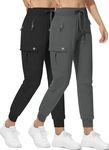Buying Guide for the Best Rain Pants For Women
When choosing rain pants for women, it's important to consider several key specifications to ensure you get the best fit for your needs. Rain pants are designed to keep you dry and comfortable in wet conditions, so understanding the different features and how they align with your activities and preferences is crucial. Here are the key specs to look out for and how to navigate them.WaterproofingWaterproofing is the ability of the rain pants to keep water out. This is crucial because the primary purpose of rain pants is to keep you dry. Waterproofing is often measured in millimeters (mm) and can range from 5,000mm to 20,000mm or more. For light rain and short periods outdoors, 5,000mm to 10,000mm is usually sufficient. For heavy rain or extended periods in wet conditions, look for pants with 15,000mm to 20,000mm or higher. Consider your typical weather conditions and choose accordingly.
BreathabilityBreathability refers to how well the fabric allows moisture from sweat to escape. This is important to prevent you from feeling clammy and uncomfortable. Breathability is often measured in grams (g) and can range from 5,000g to 20,000g or more. For high-intensity activities like hiking or running, higher breathability (15,000g to 20,000g) is recommended. For less strenuous activities, lower breathability (5,000g to 10,000g) may be sufficient. Think about how active you will be while wearing the pants to determine the right level of breathability.
Fit and ComfortFit and comfort are essential for ensuring that the rain pants do not restrict your movement and feel good to wear. Rain pants come in various fits, such as slim, regular, and relaxed. Slim fit is more form-fitting and may be better for activities where you need to move quickly. Regular fit offers a balance between comfort and mobility, suitable for general use. Relaxed fit provides more room and is ideal for layering over other clothing. Consider your activity level and personal preference for comfort when choosing the fit.
DurabilityDurability refers to how well the rain pants can withstand wear and tear. This is important if you plan to use them frequently or in rugged conditions. Durability is often indicated by the denier (D) rating of the fabric, with higher numbers indicating stronger material. For occasional use in mild conditions, a lower denier (20D to 40D) may be sufficient. For regular use in harsh conditions, look for higher denier (50D to 70D or more). Assess how often and in what conditions you will use the pants to choose the right durability level.
Weight and PackabilityWeight and packability refer to how heavy the rain pants are and how easily they can be packed away. This is important for convenience and ease of carrying, especially if you need to pack them in a backpack. Lightweight and packable rain pants are ideal for activities like hiking or travel, where you need to minimize weight and space. Heavier pants may offer more durability and protection but can be bulkier. Consider how you will carry the pants and your need for portability when making your choice.
VentilationVentilation features, such as zippered vents or mesh linings, help to increase airflow and reduce overheating. This is important for maintaining comfort during high-intensity activities or in warmer weather. Pants with good ventilation are ideal for activities like hiking, running, or cycling. If you plan to use the pants in cooler conditions or for less strenuous activities, ventilation may be less of a priority. Think about your typical activity level and climate to determine the need for ventilation features.























